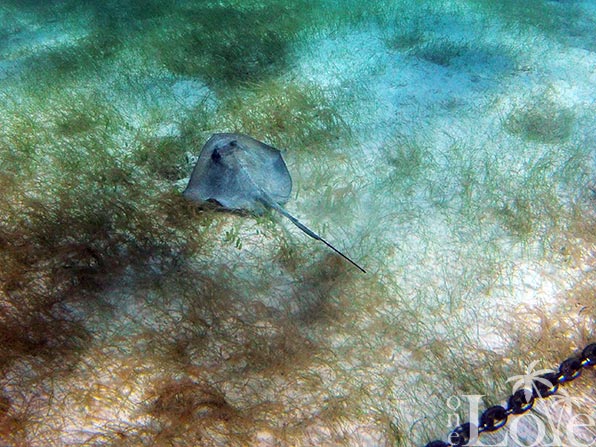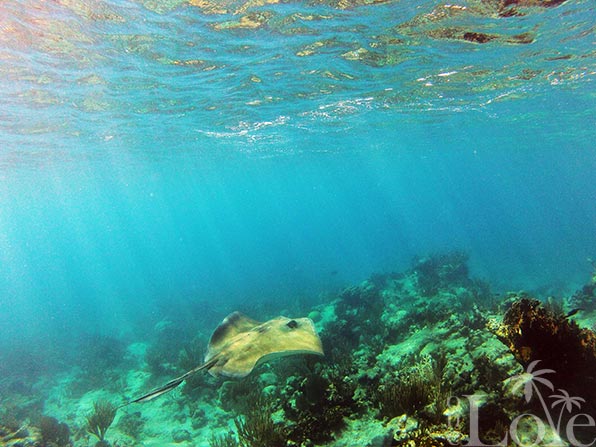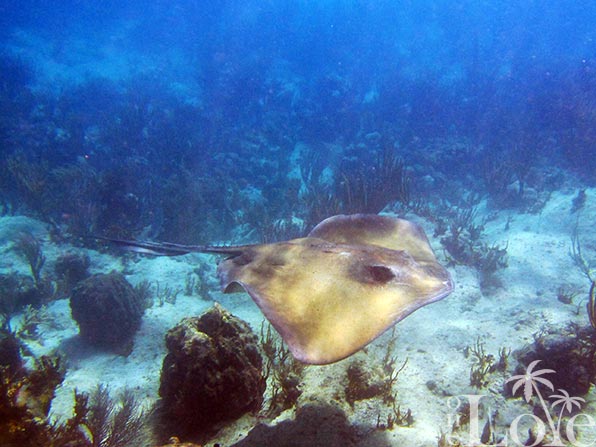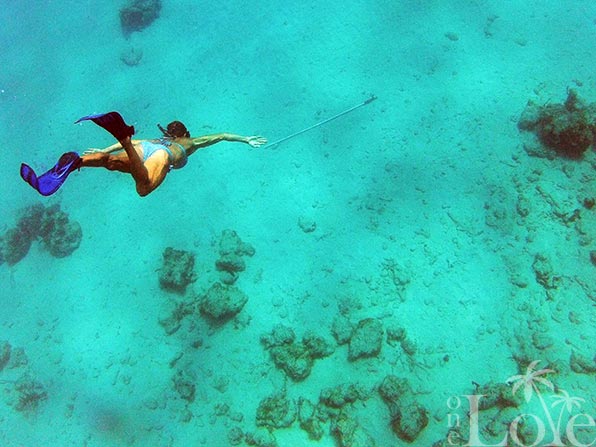You can call me Ray…
One of the great things about living on a boat is the abundance of wildlife that literally lives right under our home. One of our favorite activities is exploring this underwater realm. While divers may be able to visit depths that we can not, there is much to be seen with only a mask, snorkel and a pair of fins. Take for instance the rays shown in the pics below. While anchored in a secluded bay in the BVI, I found 4 of these guys hanging out under our boat.



Later, as me moved One Love to a popular dive/snorkel site, we found the giant ray shown below gliding along amongst the coral. He is definitely the largest ray that we have seen in the Caribbean!



While snorkeling, we were pleased to find an even more rare underwater species, the boatpolus dropus. We retrieved this creature from the water and returned him to his natural habitat, on board a boat. Just last evening we found out that our friends are in need of such a creature so we will be passing him along to them later today.




Reminds me of when I found a boatladderus leftbehindus on one of the local islands. I hear that particular variety fetches a good price at the market.
Nice find!
What do rays feed on?
Mike
I looked that up this morning:
http://en.wikipedia.org/wiki/Manta_ray
“As filter feeders, manta rays consume large quantities of zooplankton in the form of shrimp, krill and planktonic crabs. An individual manta eats about 13% of its body weight each week. When foraging, it slowly swims around its prey, herding it into a tight “ball” and then speeds through the bunched organisms with a wide-open mouth. If a ball is particularly dense, a manta may somersault through it. While feeding, mantas flatten their cephalic fins to channel food into their mouths and the small particles are collected by the tissue between the gill arches. As many as fifty individual fish may gather at a single, plankton-rich feeding site. Mantas are themselves preyed upon by large sharks and by killer whales. They may also be bitten by cookiecutter sharks, and harbor parasitic copepods.”
But those are not manta rays.
Mike
You’re right, of course:
http://en.wikipedia.org/wiki/Stingray
Stingrays feed primarily on molluscs, crustaceans, and occasionally on small fish. Some stingrays’ mouths contain two powerful, shell-crushing plates, while other species only have sucking mouthparts. Stingrays settle on the bottom while feeding, often leaving only their eyes and tail visible. Coral reefs are favorite feeding grounds and are usually shared with sharks during high tide.
When Alicia and I stopped in the Caymans, we went to ‘Stingray City’. There we were able to feed them shrimp out of our hands. Well, out of our fist. Making a fist like going to give a thumbs up, minus the thumb. They came right up (in shallow water) and sucked them up like a vacuum cleaner. Careful or they leave hickeys.
🙂
How deep was that contraption, looks like a nice free dive depth- 20ft? Also, through your travels, have you seen any spotted eagle rays, those are beautiful! You guys should really try out scuba, I’m sure you would love it.
My guess is 20′ or so. We have seen spotted eagle rays although from the deck of our boat, not while snorkeling.
The last picture, rising up to the surface with the various hues of blue is magazine quality beautiful. Really mystic and gorgeous, great promo material! Oh, and free boat hook! The sea giveth and taketh.
Thanks, Dave!
During my first tropical snorkeling experience (Hawaii, 85′) I lucked upon about 50 of the much sought after dollar swimicus, moving in single file formation across the sand flats just inside the outer reef, about 1/2 mile from the beach. Someone was laundering money, I guess. Since my shoes had exploded on the way to the beach and I had miles to go barefoot, I gave them to a local shop owner who promised to keep them safe, in exchange for my safeguarding a pair of sandals.
Nice!